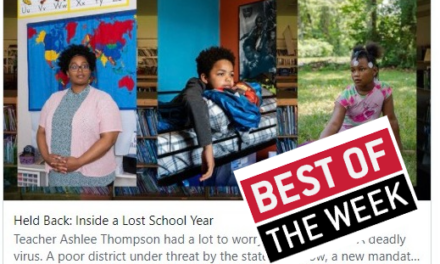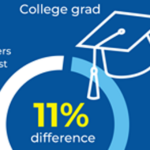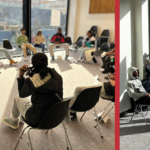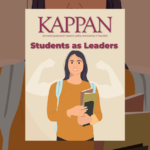Despite numerous challenges, the education team at Seattle’s largest paper found ways to divide the labor, report on readers’ immediate interests, and stay focused on addressing equity issues.
By Madison Miller
The world’s attention shifted to Kirkland, Washington, on February 29 when it was reported that Life Care Center of Kirkland, a nursing and rehabilitation facility, had the first confirmed COVID-19 death in the U.S.
As the effects of the pandemic rippled across the state, local schools were among the first to close. The Seattle Times was there to report the virus’ impacts.
The education team was on the front lines of what would quickly become a national story.
EARLY COVERAGE
Initially, “it was an all-hands-on-deck story,” said Education Lab editor Joy Resmovits in a phone interview.
Regardless of beat, all Seattle Times reporters worked together to provide breaking coverage.
Among them, Neal Morton wrote a story detailing how churches, mosques and synagogues were initially responding to the coronavirus. Dahlia Bazzaz assisted in reporting on a story regarding Boeing Field and two Eastside properties being used to house homeless people during the pandemic.
As the constant stream of COVID-19 news began to subside, EdLab reporters returned to covering only education.
Bazzaz’s first COVID-19-related story Feb. 27-28 focused on the shutdown of Bothell High School.
What started with one school closure led to dozens and then, ultimately, all schools throughout the state.
Early coverage aimed to answer frequent questions including What happens if school closes? How to talk to kids about the coronavirus? and When will it be safe to reopen?
“From the get-go, we wanted to know how we can be most useful,” Resmovits said. These stories, and others, were also published in Spanish, Somali, and Tagalog.
Since the beginning of the outbreak, the team has produced more than 60 stories related to the impact of COVID-19 on education. The stories highlighted various angles, including the virus’ impact on students, families, teachers and schools.
MIXING AND MATCHING
To provide the best COVID-19 coverage, Resmovits said the team developed mini beats.
Bazzaz focused mostly on online distance learning and opportunity gaps and Hannah Furfaro took on health and science effects on remote learning.
There were some challenges along the way. Longtime reporter Morton left his position in mid-March for a new job with the Hechinger Report. The team brought in a 30-year Seattle Times veteran, Katherine Long, to replace him temporarily.
“Of course, losing Neal was hard,” said Resmovits. “But, between Katherine’s return and our continued collaboration with Neal in his new role at Hechinger, we hope our readers don’t feel like they’ve experienced any disruptions in service.”
Related stories: Covering NYC’s school shutdown and relaunch
FOCUSING ON EQUITY
The Seattle Times Education Lab (EdLab) is funded by the Solutions Journalism Network and the Bill and Melinda Gates Foundation to write in-depth, solutions-based stories about education, as opposed to traditional metro reporting on education. However, education reporters write both EdLab and metro stories.
A major part of EdLab’s coverage features issues of equity in education.
Furfaro said the team maintained its equity lens while reporting during the pandemic.
“We still keep our equity lens in mind when we’re writing these stories,” Furfaro said.
“It’s more important now than ever,” Bazzaz said. “Looking at how kids are getting meals now they’re out of school, how high school seniors are navigating college decisions.”
The pandemic has allowed the team to highlight stories outside of classroom instruction, Furfaro said.
Over the course of several weeks, Seattle Times education reporters explained how teachers are adjusting and creating curriculum to accommodate distance learning, why Seattle students are among the last in the region to receive laptops, and how high school seniors will be able to graduate despite missing certain requirements.
Sign up here for the week’s best education news and newsroom comings and goings.
REMOTE REPORTING
Like other news outlets, EdLab has been reporting while practicing social distancing since mid-March. Reporters say it’s been challenging not being able to meet with sources in person or to witness an event and report on their own observations.
“I’ve been doing my interviews over the phone or via webcam. It works, but face-to-face is always preferred,” Furfaro said. She’s also tried sitting in on remote classes to get a sense of how things are going. “It’s a very different way of reporting, but we’re trying to be creative.”
Bazzaz and Furfaro wrote a story highlighting how different Washington school districts are approaching remote learning. Interviews with teachers, students, and officials all happened remotely. Bazzaz and Furfaro described what one remote class looked like.
“The teens, students of White River High School, trickled in slowly, their faces and bedrooms appearing in boxes at the top of Zoom video chat app. Schumacher sat in front of window blinds with sunlight pouring through, and welcomed the new arrivals cheerily. ‘Good morning, Jeremy!’ she chimed. ‘You figured it out.’ As she explained deadlines and logistics for completing yearbook pages, Schumacher’s 7-year-old son, Flynn, occasionally popped into view. The barks of her dog, a Vizsla named Lucky, could be heard,” Bazzaz and Furfaro wrote in their story, Is school really out? Washington state school districts answer that question differently during the coronavirus closure.
Playing to reporters’ strengths, and being strategic in using time and resources, the EdLab team has been successful in reporting during the pandemic, Resmovits says.
Bazzaz said reporters have the opportunity to do retrospective reporting, especially now that the early barrage of COVID-19 breaking news has subsided some. She said there are always new story angles to explore when it relates to the pandemic because things change so quickly.
Related coverage: Covering Chicago’s first week of remote learning
POSITIVE FEEDBACK
Throughout EdLab’s coverage of the pandemic, Resmovits said the team has received messages of support and praise from readers and fellow journalists.
“I’m really proud to be a part of this area’s group of education reporters,” she said. “We’ve all [local education journalists] done a great job and continue to do so.”
The Grade reached out to several other education reporters and education experts to comment on EdLab’s coverage of the pandemic, either by email or social media. Some declined to comment and others did not respond by the reporter’s deadline.
Related stories:
30 stories in 7 days: a close look at Boston-area education coverage
Covering Chicago’s first week of remote learning
Covering NYC’s school shutdown and relaunch
Seattle Times stories:
New Approach In Seattle Includes Live Events, Social Media (& Also “Solutions”)
Seattle Times & NBC Coverage Of Teacher Predictions Study Stands Out
ABOUT THE AUTHOR

Madison Miller
Madison Miller is a Seattle-area freelance reporter. You can follow her at @madisonr_miller













